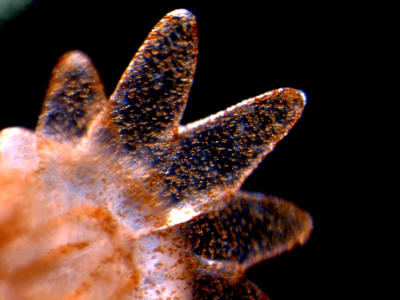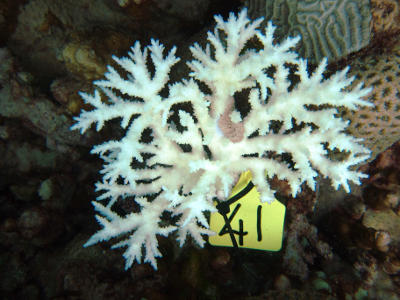Using AI to control energy for indoor agriculture
30 September 2024
Published online 15 October 2015
Can previously unknown algae save coral reefs from the damage expected from climate change?

© Emily Howells
Scientists deem a safe CO2 concentration in the atmosphere is 350 parts per million. In April 2014, atmospheric CO2 levels reached 400 parts per million and continue to rise.
To study how a rise of temperature would affect coral reefs, scientists at New York University Abu Dhabi (NYUAD) in the United Arab Emirates are looking at the extreme temperatures of the Persian/Arabian Gulf.
“Given that our summer sea temperatures regularly exceed 35°C – well beyond what is predicted to be experienced by coral reefs in most other regions under the next century of climate change – the biology of reef fauna in the Gulf can provide some incredible insights into how corals and other reef-associated organisms might cope with future climate change,” says NYUAD marine biologist, John Burt.
Burt and collaborators at the University of Southampton in the UK have discovered a unique species of algae believed to play an intrinsic role in the ability of Gulf corals to survive extreme temperatures.
A type of unicellular algae known as Symbiodinium lives inside coral tissue. Corals use their tentacles to feed on drifting plankton. After digestion, some of the nutrients are passed on to their algal partner. In exchange for these nutrients, the algae pass some of the energy they produce through photosynthesis to the corals. This mutual dependency, or symbiosis, is so intrinsic that one could not survive without the other. “The coral gets roughly 90% of its energy from sugars produced by the photosynthetic algae and only 10% from its own feeding,” Burt explains.
This symbiotic relationship can break down, however, due to various stressors – the most common being unusually high water temperatures. When that happens, the number of algae living in the corals drops sharply, leaving a colourless coral tissue in a process called bleaching.
Corals can survive for up to two weeks after bleaching by living off their reserves. But if the stress continues, the corals may fail to re-establish a symbiotic algal community and starve.
Burt’s team has found a previously unknown species of Symbiodinium, which they have named Symbiodinium thermophilum, that lives in the corals of the extreme environment of the southern Persian/Arabian Gulf. This symbiotic relationship is able to survive the region’s normally high summer sea temperatures3.

© Emily Howells
“Symbiodinium thermophilum is widespread in the southern Gulf, but it becomes much less common in corals just outside in the Gulf of Oman and Arabian Sea area where conditions are less extreme,” says Burt.
This raises questions, he says, of whether this unique species will naturally migrate to other regions as the world’s oceans warm, or will human-assisted migration be advantageous?
It is also possible that S. thermophilum may already exist in other areas at very low density but they have not yet been recorded because those regions are not warm enough to select for this heat-tolerant species.
Burt’s most recently published research shows that corals associated with S. thermophilum show strong local adaptation, not only to high temperatures, but also to the exceptionally high salinity in the Persian/Arabian Gulf4. In fact, their superior heat tolerance can be lost when they are exposed to the lower salinity in other waters.
This may form a barrier preventing coral/S. thermophilum relationships to develop elsewhere.
Emily Howells, a postdoctoral researcher at NYUAD’s Marine Biology Lab, is working to understand the adaptive potential of Arabian Gulf corals. By exposing corals and their offspring from different populations to heat stress experiments, she is trying to determine whether the genetic background of the coral animal or their algal symbionts are responsible for their enhanced heat tolerance.
Her results so far demonstrate that both symbiotic partners are important.
For example, in a common species of brain coral, coral hosts from the Gulf are, on average, twice as heat tolerant as those from elsewhere. Similarly, the Symbiodinium algae within these Gulf corals are up to three times as heat tolerant.
“This finding shows that the ability of coral populations to cope with warming will be influenced by the rate at which symbiotic partners can adapt together,” says Howells.
Corals in the Gulf represent a critically important asset for reef science.
Howells is now examining the Arabian Gulf brain coral genome with colleagues from Oregon State University to identify regions linked to high heat tolerance. She hopes her work will provide information on the potential of Persian/Arabian Gulf corals to continue to adapt to warming.
Despite Persian/Arabian Gulf corals’ unique ability to acclimate and adapt to extreme sea surface temperatures, they have not been immune to mass bleaching events.
In 1996 and 1998, summer temperatures rose more than 2°C higher than the normally high summer temperatures. These extreme temperatures pushed many corals over the brink, with more than 90% of live corals lost from reefs across hundreds of kilometres of coastline in the southern Gulf by late in the decade.
Other bleaching events followed in the next decade, making recovery extremely difficult and reversing some of the regeneration that had taken place. Large-scale coastal development projects throughout the Gulf have also undermined marine ecosystems.
“One clear message is that corals in the Gulf represent a critically important asset for reef science and potentially for the longer term survival of coral reefs generally, and that there is a real need to ensure the conservation of corals in this region,” Burt emphasises.
“Unfortunately, reefs in this area have been undergoing considerable decline in recent years as a result of various anthropogenic stressors. There is a risk that we may lose these important biological and scientific assets unless there are rapid and dramatic efforts by marine management to preserve the valuable reef resources in the region.”
doi:10.1038/nmiddleeast.2015.191
Stay connected: